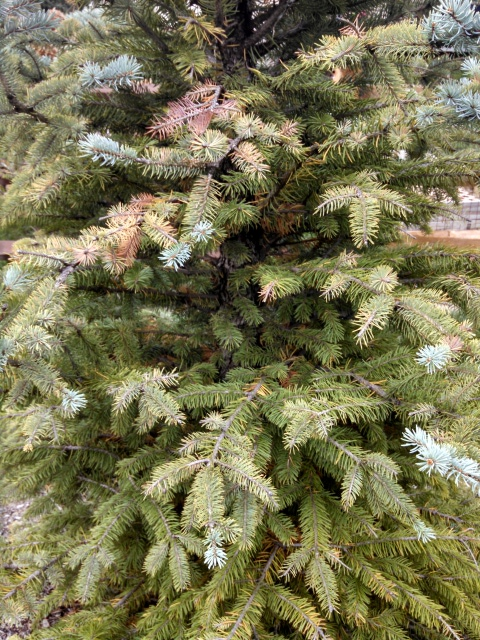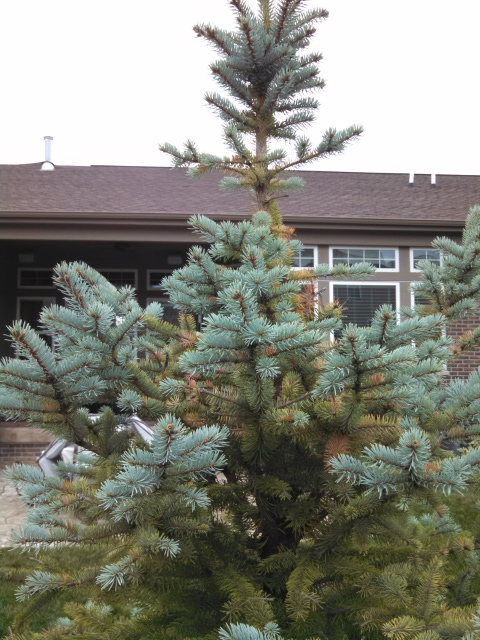QuestionQUESTION: 4 years ago we had 4 Fat Albert's planted out back. They are on a small mound each. First year and half they seem to do well. At about 19 months 2 of them started to turn brown, the nursery suggested we reduce the water which we did by having the sprinklers redirected and things seem to pick back up in the spring of this year until about 2 months ago and the same 2 trees seem to have started to turn brown again. I thought maybe it is the lawn service which applied bug spray as treatment might be the problem but I am getting the idea they don't feel the same. The lawn service has suggested I put Phosphorus fertilizer around 20 or higher. I have no idea how much on each tree and if this is correct solution. Could someone offer suggestion? 2 of the trees seem to be doing fine and the tops of the 2 tree in stress seem to be doing ok. None of them are all blue any longer except the very new growth on top of each tree. They were completely blue when planted.
ANSWER: Ok I need a little more detail. Are the brown needles over the entire tree, near the trunk, or on the outer edges of the branches? The reason I am asking is that conifer trees do lose needles and these are the older ones nearer the trunk.
Also you may want to check for spider mites. The spruce spider mite is a common 揷ool season?mite found on all types of conifers (spruces, pines, junipers and arborvitae). Spruce spider mites are active in the spring and fall. They become dormant during the heat of the summer and survive as 搑esting?eggs. These eggs and adults resume activity in the fall when cooler temperatures return. Conifers often react slowly to the spruce spider mite feeding. Yellowing and bronzing of the needles may not become apparent until mid-summer, even though the damage occurred the previous fall or spring. Spider mites are tiny and difficult to see with the naked eye. A convenient detection technique is to hold a sheet of white paper under a branch and then shake or tap the branch against the paper. The mites, if present, will show up as tiny, slow-moving specks on the paper.
The best time to fertilize is early April, before new growth expands, but you can apply fertilizer anytime until midsummer (roughly July 15). Applications beyond this period will stimulate growth late enough in the season that it may not have time to harden off before cold temperatures arrive. Such growth is much more likely to suffer winter injury and dieback. It is always best to have a reliable soil test run before fertilizing, as much of our soil already has sufficient amounts of phosphorus and needs no extra. Testing will also show whether the soil is acidic or alkaline. Generally, evergreens grow better when soil conditions are acidic; many nutrients may be unavailable to the plant when soil is too alkaline.
IF I was to fertilize them I would use a balanced fertilizer like 13-13-13 at the rate of 1 lb per inch of trunk diameter scattered around the tree and watered in good. Apply just be for a rain storm and you will not have to water. But I would first take the soil test.
A picture of the damage might help me id the problem.The insecticide would not have harmed the tree but you need to not use a product for lawns called Weed and Feed. This contains a herbicide that will kill the roots of trees. Without more information this about the best I can do.
---------- FOLLOW-UP ----------
 FAT ALBERT BS
FAT ALBERT BS  TOP
TOP
QUESTION: The needles appear to be the length of the branch. I am attaching pictures as requested. The trees were not treated with a weed and feed, lawn service says it was specific to the type of trees. The tops of the trees seem to be doing ok, just the middle to bottom. See second picture.
Bob
AnswerI think it looks like mites. Mites are not insects but are more closely related to spiders. Spider mites are occasional pests of spruce and arborvitae. They are very small and not seen easily with the naked eye. They have piercing mouthparts that they use to suck plant sap. Their feeding results in speckling (formation of tiny yellow spots) on needles. Some needles may turn brown and drop off usually in the lower limbs.. With heavy infestations, fine webbing may be seen on the plant. Several seasons of heavy mite feeding may kill an arborvitae. Although most spider mites increase in numbers during hot, dry weather, spider mites are cool-weather mites. Their populations peak during spring and fall, but drop dramatically during the heat of summer when predators feed on them.
To determine whether insecticide use is needed, it helps to know how many mites are present. Hold a white sheet of paper under a branch and strike the branch. The mites that are knocked off will be seen crawling around on the paper. If dozens of mites are seen per whack, serious damage can result. Continue to check population numbers at 7- to 10- day intervals. Pesticides labeled for homeowner use against spruce spider mite include insecticidal soaps and acephate + fenbutin oxide (Ortho Systemic Insect Killer or Ortho Orthenex Garden Insect & Disease Control Concentrate). Completely cover the foliage with the spray. As with any pesticide, read and follow all label directions and precautions before using.
If it is spider mites if you treat the tree should look better next spring.







